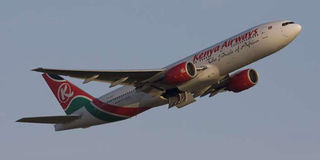When pilot error led to deaths of 169 in Kenya Airways crash

A Kenya Airways plane in flight. PHOTO | FILE | NATION MEDIA GROUP
What you need to know:
- According to the investigators, the crew failed to apply the TOGA (take-off/go around switch) thrust, as recommended by the flight crew operating manual.
- Had they activated this, they would have pulled in full power from the engines to ensure maximum thrust from the engines.
- Investigators attributed the crash to pilot error.
On Sunday, January 30, 2000, Kenya Airways Flight 431, an Airbus 310-304 registered 5Y−BEN and tagged "The Harambee Star", was undertaking a scheduled international flight KQ431 from Abidjan to Nairobi via Lagos.
The flight took off from Abidjan en-route to Lagos. Hours later, and after holding for about 30 minutes over Lagos airspace, the plane was unable to make a landing because of haze and poor visibility, caused by the ''harmattan'', a seasonal wind from the deserts of North Africa.
The 14-year-old plane landed at Félix Houphouët-Boigny International Airport in Abidjan at 3.15pm.
The relief crew, which had arrived two days previously on flight KQ 430 on Friday, January 28 at 3.44pm, took over on board 5Y-BEN, to undertake flight KQ 431 from Abidjan to Nairobi via Lagos.
The new 10-person crew and the aircraft took on several passengers bound for Nairobi via Lagos, putting the total on board at 169 passengers. The departure was scheduled for 9pm on a clear moon sky, in accordance with the initial programme. At exactly 20:55:22, the crew established contact with Abidjan Airport control tower and asked for start-up clearance. This was granted.
According to the audio transcript of the pilot communication provided through the accident report prepared for the Ivory Coast National Civil Aviation Agency (ANAC), at 21:01:07, the crew of 5Y-BEN asked for clearance to taxi. The tower controller put them on standby. A few seconds later, he cleared them to taxi.
The airplane began to taxi at 21:07:35 as the tower controller informed the crew of the latest wind, cleared them to take off and asked the crew to call back when they reached flight level 40.
At 21:07:45, the co-pilot read back the clearance. This was the last communication between the crew and the control tower.
At 21:08:50, the audio recording captured the pilot announcing "V1 and Rotate (4)", then two seconds later "Positive". The airplane took off. It would only be airborne for a minute and 34 seconds before it crashed into the Atlantic Ocean, some 2.7 kilometres off the runway, killing all but 10 passengers. This would be the first KQ crash to record fatalities.
According to the accident report, out of its 179 passengers, 146 bodies were recovered and 23 were never found. Twelve survivors, who were all passengers, were found on the night of the accident. Unfortunately, two later succumbed.
Despite the Ivory Coast emergency teams, including the French military, scrambling search and rescue teams in the dead of the night, the crash site was located at exactly midnight, when “one of the pleasure boats signalled a strong odour of kerosene in the east of the extended runway centre line area.” The rescue ships then manoeuvred in that direction.
Twenty minutes later, the first survivor was recovered by the pleasure boat NRJ, who was then transferred to the tug San Pedro. In 15 minutes, three more survivors were recovered and transferred to the San Pedro. These survivors were treated on the tug by SAMU doctors while awaiting evacuation to hospital.
“The airport firemen discovered a survivor on the beach in the Adjouffou quarter and transferred him to the airport medical centre in an ASECNA vehicle. He was then transferred to the Sainte Anne-Marie medical clinic in Abidjan,” the accident report reads in part.
By 4am, the search and rescue teams had recovered and transferred to hospital the 12 survivors. The survivors stated that, for the take-off, they heard an announcement to fasten their seatbelts for an imminent departure. The cabin crew performed checks to ensure that the passengers’ seatbelts were fastened.
According to the survivors, the airplane took off normally. A survivor said that he noticed that the airplane did not gain altitude as usual but rather lost height.
“An airport baggage handler said that the take-off did not seem normal to him and that he saw the airplane flying very low. It seemed to him that the airplane then disappeared rapidly from sight behind a bank of fog,” read part of the report.
Several survivors stated that a short time after take-off, the airplane started to descend rapidly. The airplane seemed to them to have swung suddenly to the left, then to the right, then to crash into the ocean with a deafening noise. The survivors noticed that electrical power in the aircraft was shut off, though they were unable to say when this happened exactly.
“They stated that there was no announcement from the crew before the accident,” the report said. Those who survived the accident said that they hung on to various floating objects.
So what really caused Flight 431 to crash? As the plane lifted off the tarmac at Abidjan, a stall warning (an alarm that alerts the pilot of air speed passing over the wings reduction) activated as soon as the aircraft left the ground. This alarm beep basically warned the pilot that the aircraft wasn’t generating any lift.
Procedurally, according to the cockpit recordings, the pilot, upon getting the stall warning, stopped the post-takeoff checklist.
He then pushed the control column forward immediately, having activated the stick shaker. According to the investigators, the crew failed to apply the TOGA (take-off/go around switch) thrust, as recommended by the flight crew operating manual.
Had they activated this, they would have pulled in full power from the engines to ensure maximum thrust from the engines.
Investigators attributed the crash to pilot error.





